June 22, 2025

The article titled "8 Discrimination Training ABA Examples to Enhance Your Practice" presents practical examples and techniques in Applied Behavior Analysis (ABA) aimed at improving discrimination training. It underscores the necessity of personalized approaches, particularly through the use of positive reinforcement and the assessment of individual needs. This focus is crucial for effectively enhancing learning outcomes, especially in light of the increasing demand for Board Certified Behavior Analysts (BCBAs) in bias reduction roles.
Are you aware of the growing need for qualified BCBAs? As the field of ABA evolves, so does the requirement for professionals who can implement effective discrimination training strategies. By leveraging the insights from this article, practitioners can not only enhance their skills but also meet the pressing demand for expertise in this area.
The emphasis on tailored strategies, such as assessing individual needs and applying positive reinforcement, is vital for fostering successful learning environments. This approach not only benefits learners but also positions BCBAs as essential players in addressing bias within various settings.
In conclusion, the insights provided in this article serve as a call to action for practitioners to refine their techniques and embrace personalized methods in their practice. By doing so, they can significantly contribute to the field of ABA and the reduction of bias, ultimately enhancing the effectiveness of their interventions.
The demand for Board Certified Behavior Analysts (BCBAs) is on the rise, underscoring a critical need for effective discrimination training techniques within Applied Behavior Analysis (ABA). As professionals strive to enhance their practices, it becomes essential to understand and implement practical examples of discrimination training. Yet, with a multitude of strategies available, how can BCBAs discern the most effective methods to guarantee meaningful learning outcomes for their clients? This article delves into eight compelling examples of discrimination training in ABA, providing valuable insights into techniques that not only facilitate skill acquisition but also address the unique challenges encountered in this ever-evolving field.
The demand for Board Certified Behavior Analysts (BCBAs) is projected to rise by an astonishing 25% by 2026, particularly in specialized fields like bias education. This surge underscores the urgency for effective recruitment solutions. Hire ABA functions as a specialized recruitment platform dedicated to connecting BCBAs with job opportunities specifically in bias reduction roles. This focused approach addresses the unique needs of both job seekers and employers, significantly enhancing the hiring process.
With a staggering 1,942% increase in demand for BCBAs from 2010 to 2018, the urgency of hiring needs in this sector is undeniable. Hire ABA guarantees that qualified professionals can discover roles that align with their skills and career aspirations. Our personalized resume assessments involve a thorough evaluation of candidates' experiences and career goals, utilizing advanced job fit scoring to match them with the best roles based on their preferences and desired locations.
As organizations increasingly recognize the importance of specialized instruction in addressing behavioral challenges, the role of platforms like Hire ABA becomes crucial in fulfilling the rising need for skilled BCBAs. Are you facing challenges in your hiring process? Consider how Hire ABA can streamline your recruitment efforts and connect you with top talent in the field of Applied Behavior Analysis (ABA) therapy. Our targeted recruitment strategies not only facilitate job matching but also enhance the overall efficiency of hiring practices. Take action today and discover how Hire ABA can transform your recruitment experience.
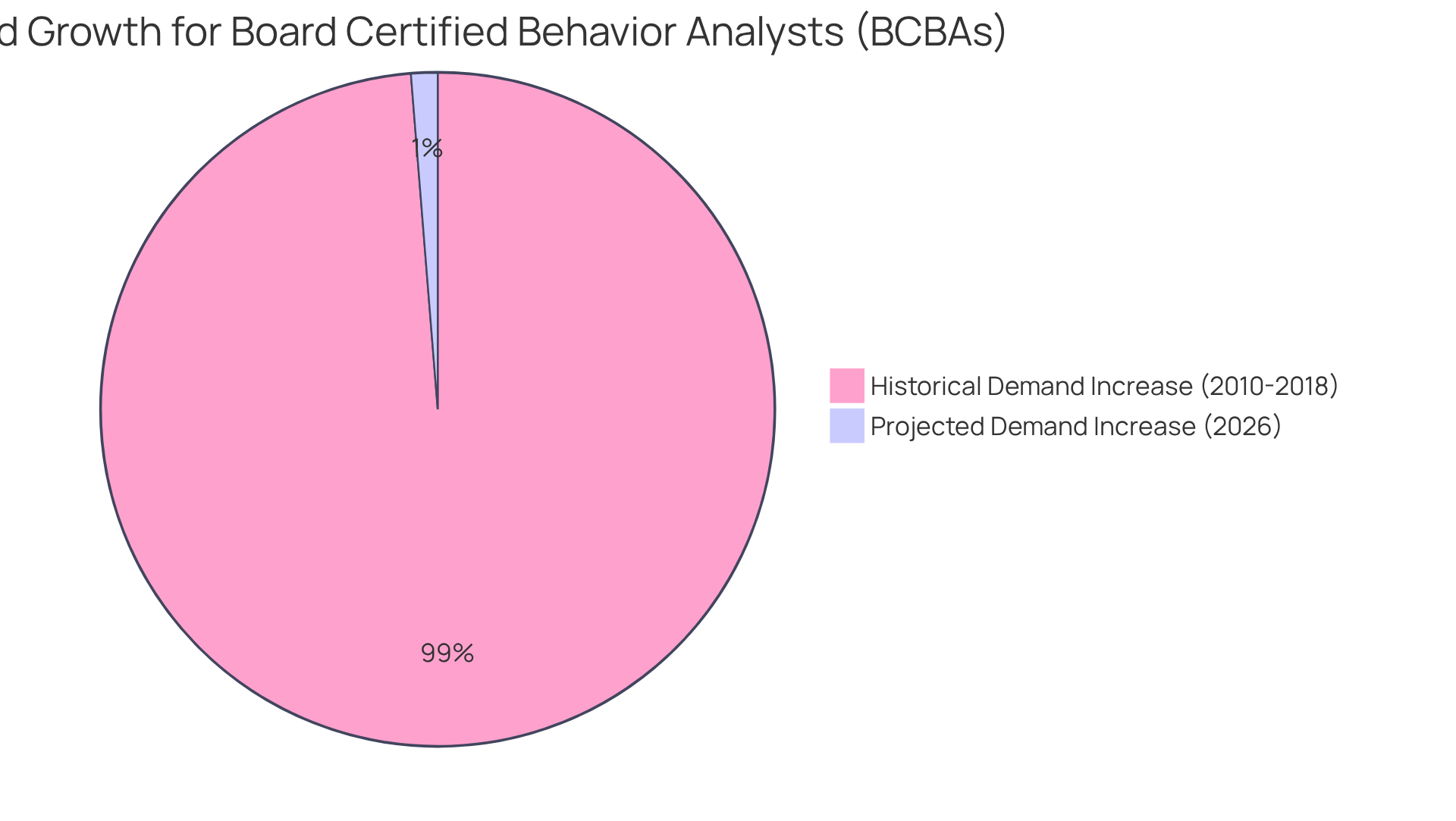
The demand for Board Certified Behavior Analysts (BCBAs) is projected to rise by 25% by 2026, underscoring the critical need for effective instructional techniques in Applied Behavior Analysis (ABA) therapy. A compelling example of discrimination training ABA in therapy involves teaching youngsters to identify colors. For instance, a therapist might use a discrimination training ABA example by presenting a young person with a red ball and a blue ball, prompting them to point to the red one. Upon correctly identifying the red ball, the child receives positive reinforcement, such as praise or a small reward. This approach not only aids in color differentiation but also strengthens learning through immediate feedback.
Research indicates that organized color discrimination instruction can significantly enhance young individuals' ability to distinguish colors, with studies revealing that those who participate in such training exhibit improved recognition abilities. According to a study published in the Handbook of Early Intervention for Autism Spectrum Disorders, effective methods for teaching colors in ABA therapy often incorporate:
BCBAs emphasize the importance of positive reinforcement in this context, noting that it not only motivates children but also solidifies their understanding of the task. By integrating these strategies, therapists can create a supportive environment that fosters skill acquisition and enhances overall developmental outcomes. As the demand for BCBAs continues to grow, it is essential for professionals in the field to adopt efficient instructional techniques that meet this expanding necessity.
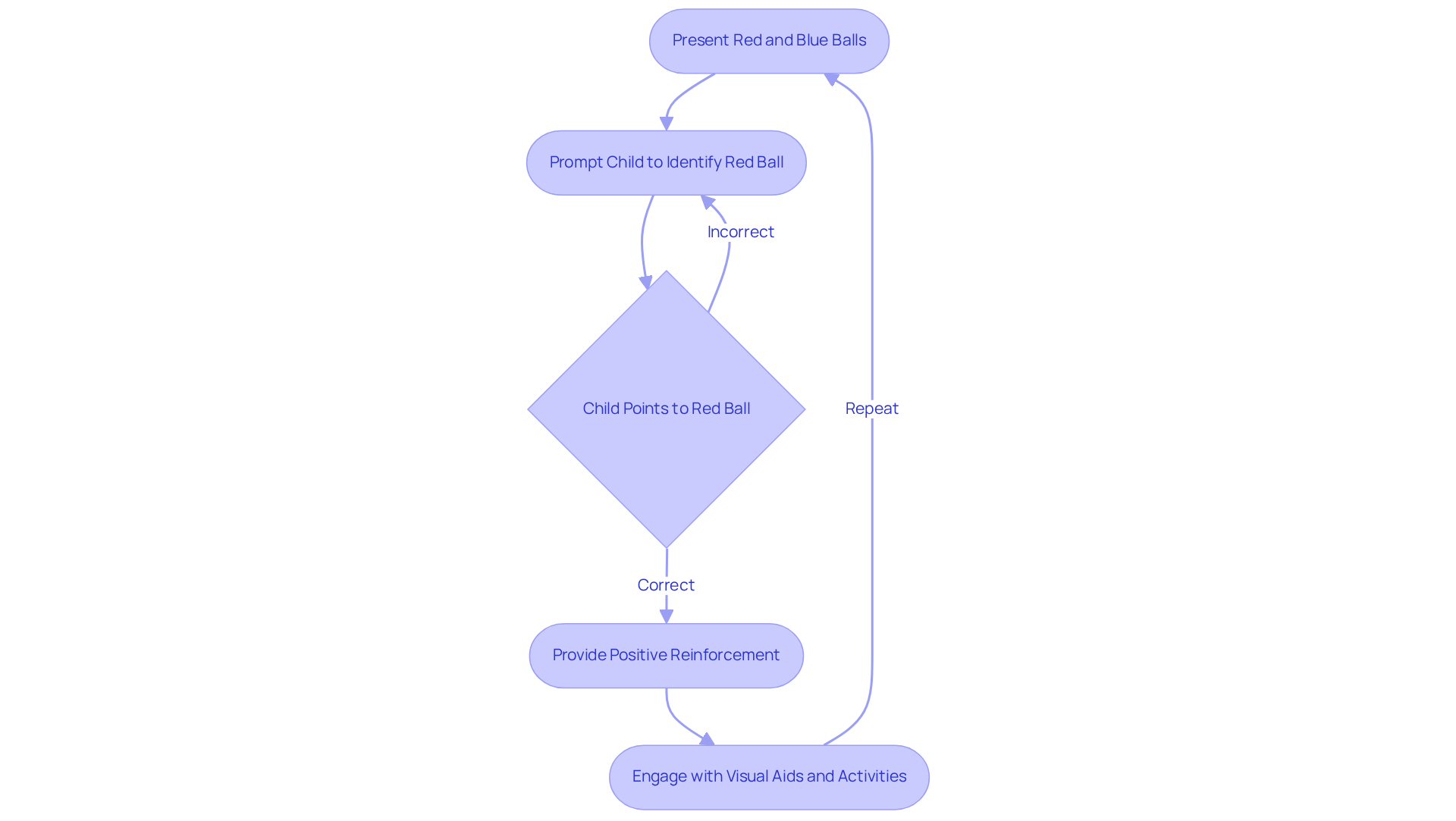
Discriminative stimuli are environmental cues that signal the availability of reinforcement for specific behaviors. For instance, when a child understands that a green light indicates 'go' while a red light signifies 'stop,' they are effectively responding to these discriminative stimuli.
Recognizing and utilizing these signals efficiently is essential in stimulus instruction, as it aids individuals in learning to distinguish between various reactions based on the cues provided. This understanding not only enhances learning outcomes but also fosters a more structured approach to behavior management.
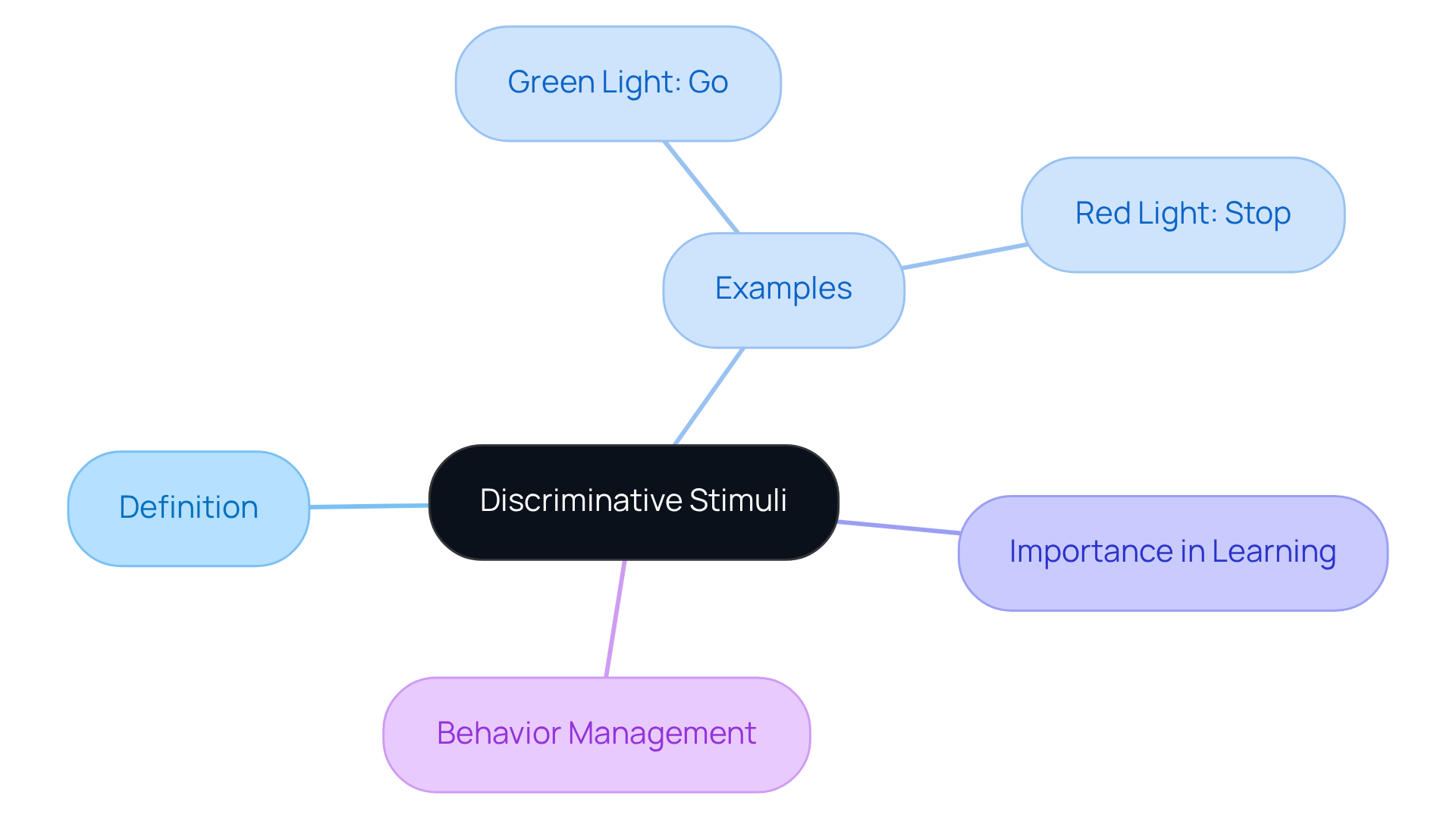
Stimulus control is a fundamental concept in behavior analysis, referring to the phenomenon where a behavior is more likely to occur in the presence of a specific stimulus than in its absence. In the realm of ABA therapy, establishing stimulus control is essential for effective differentiation practice.
Consider this: when a young individual learns to respond to a specific sound or visual cue, they are significantly more likely to exhibit the desired behavior in the presence of that cue. This principle not only underscores the importance of context in learned behaviors but also facilitates their generalization across various situations, ensuring that interventions are both effective and adaptable.
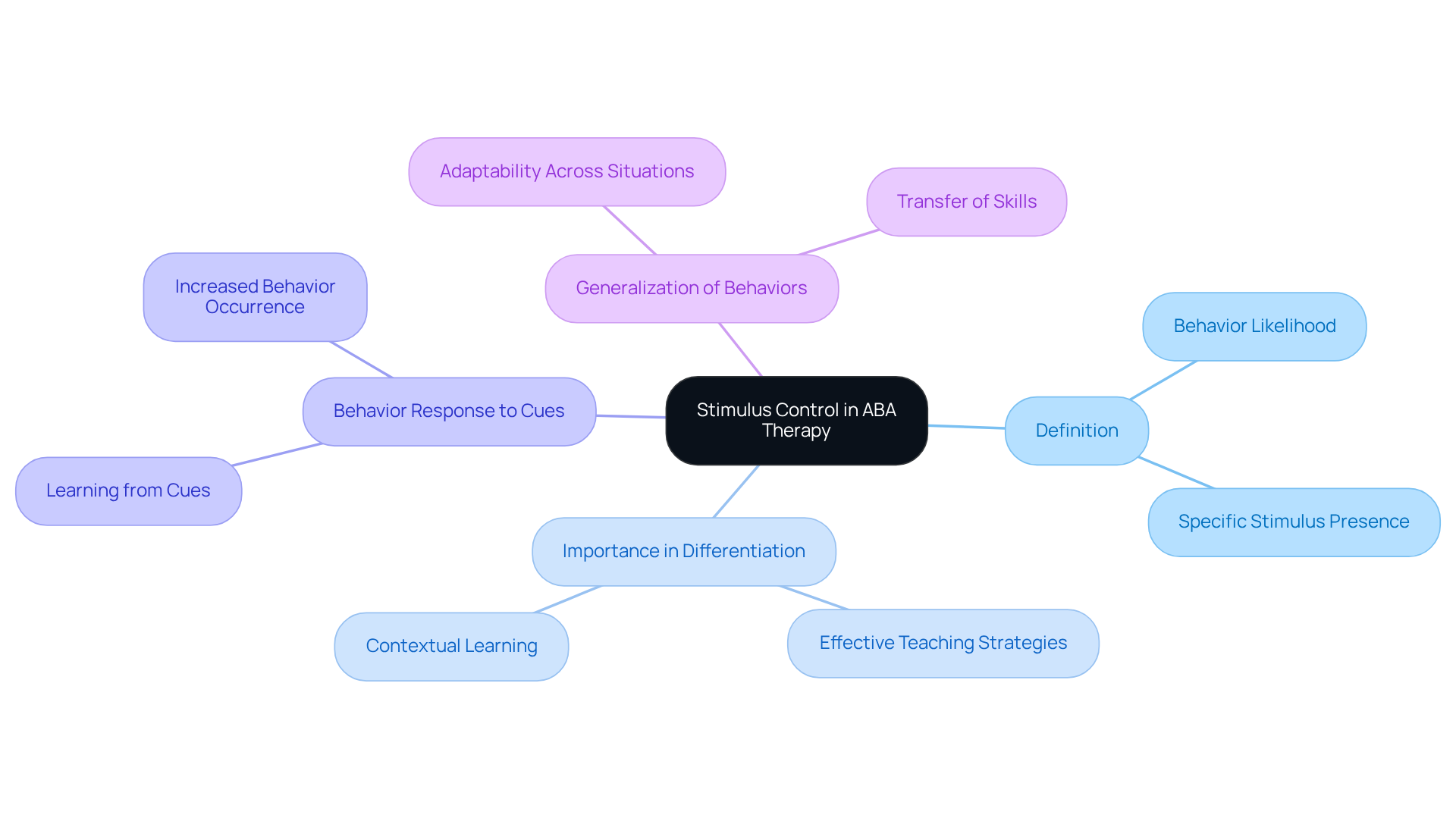
Reinforcement is crucial in teaching, significantly enhancing the likelihood of preferred behaviors being repeated. Did you know that over 90% of youngsters undergoing ABA interventions demonstrate substantial advancement in social, communication, and academic abilities? This statistic underscores the importance of effective reinforcement strategies. Positive reinforcement techniques—such as verbal praise, tokens, tangible rewards, or preferred activities—greatly enhance a learner's motivation and engagement. For instance, when a child accurately identifies a color, prompt praise reinforces that behavior, making it more likely to be repeated in the future.
Board Certified Behavior Analysts (BCBAs) must carefully select reinforcement strategies that resonate with the individual, ensuring they are meaningful and effective. Comprehensive assessments are essential for identifying individual strengths, challenges, and preferences, allowing BCBAs to tailor their approaches effectively. By customizing reinforcement strategies, BCBAs can significantly improve training outcomes.
As the demand for skilled BCBAs continues to rise, it is imperative to consider how personalized reinforcement can transform the learning experience. Are you facing challenges in hiring qualified professionals? Explore how Hire ABA can assist in recruiting the right talent to enhance your practice.
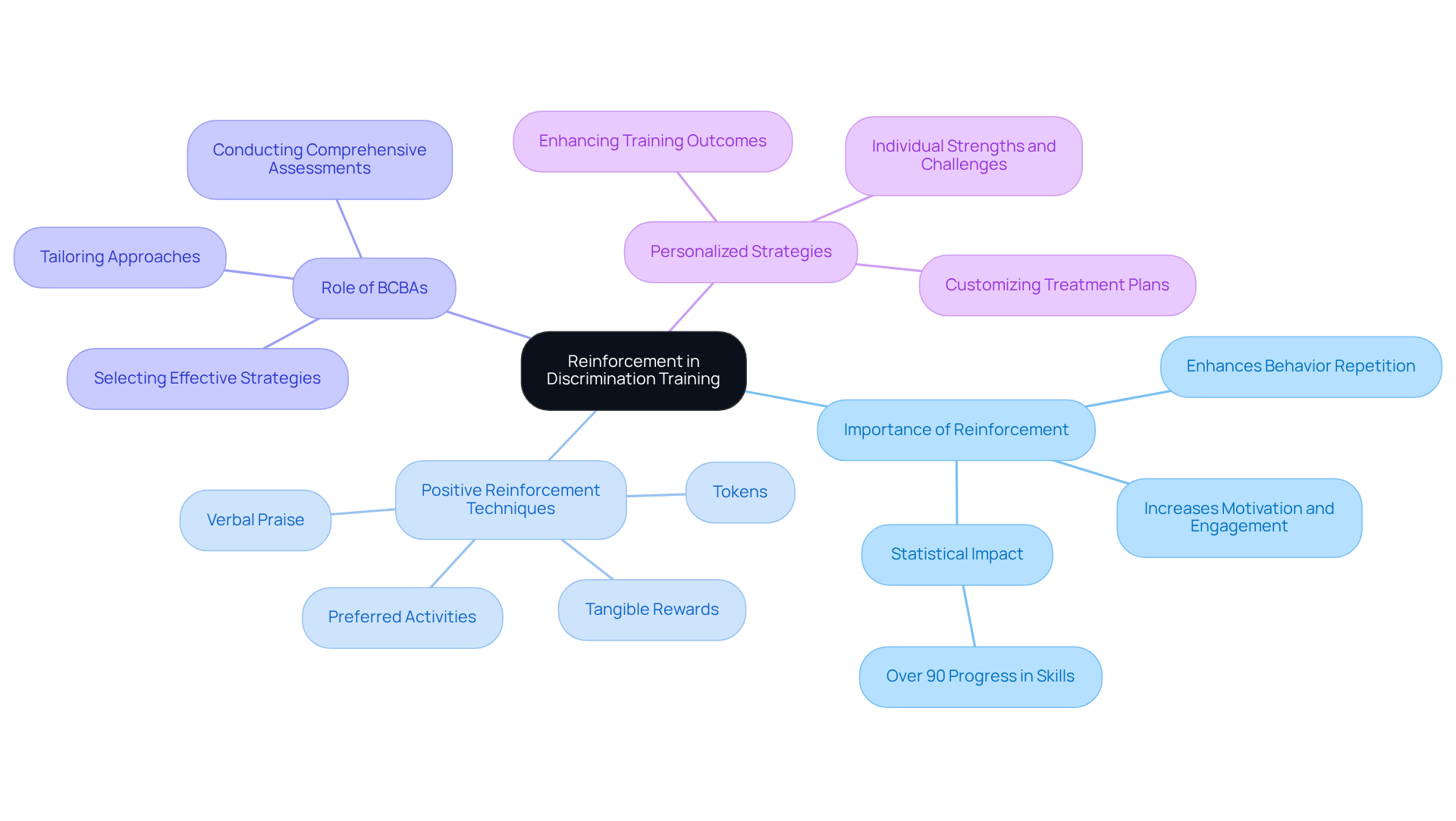
Conditional differentiation is a pivotal technique in ABA therapy, and it exemplifies discrimination training ABA example by teaching individuals to respond distinctively based on contextual cues. Consider a child who learns to identify a 'dog' upon seeing its picture, but only after hearing the term 'animal' beforehand. This approach not only deepens the understanding of intricate relationships between stimuli but also fosters adaptive behavior across diverse contexts.
Research underscores that employing these techniques significantly enhances success rates in imparting nuanced behaviors, empowering individuals to navigate their environments more adeptly. A case study on bias training illustrates that these strategies can substantially aid individuals in overcoming challenges while refining their cognitive and behavioral skills.
The meticulous planning and execution of these strategies are crucial for promoting independence and enriching the overall learning experience. As highlighted by a BCBA, 'Incorporating conditional differentiation techniques allows us to tailor our approach to each individual's needs, ultimately leading to better outcomes.'
To effectively implement discrimination training ABA example, BCBAs must prioritize gradual exposure to contextual cues and consistently reinforce correct responses.
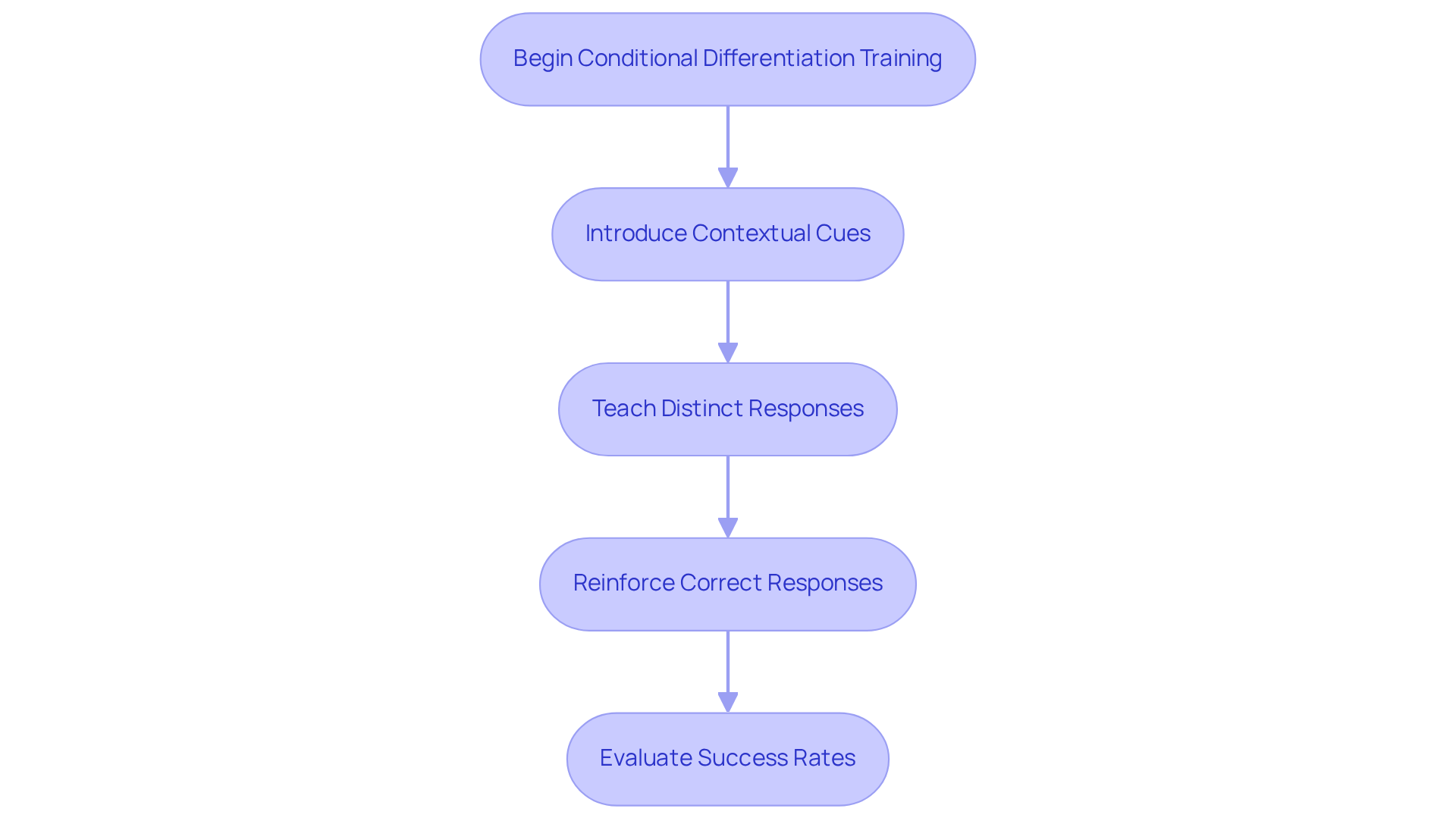
Generalization is a critical ability that enables individuals to apply learned skills in various situations beyond their initial learning environment. For example, a child who learns to identify colors in a structured setting should be able to recognize those colors in everyday contexts, such as at home or in school. To effectively promote generalization, Board Certified Behavior Analysts (BCBAs) can implement several key strategies:
Current studies indicate that effective generalization methods can lead to significant improvements in skill transfer. Research shows that children undergoing extensive ABA treatments exhibit a notable increase in their capacity to generalize skills, with a combined effect size of 1.19 for cognitive functioning and 0.95 for social functioning. Moreover, ABA is recognized as a best practice for treating children with ASD by the governments of Canada and the United States, highlighting its importance in therapeutic settings. Experts stress that successful generalization is essential for ensuring that skills learned in therapy translate into meaningful, everyday use. As Dr. Temple Grandin wisely states, 'Different, not less,' underscoring the unique abilities of individuals with autism when provided with appropriate support and guidance. By focusing on these strategies, BCBAs can enhance the effectiveness of skill development and empower individuals to navigate their environments with confidence.
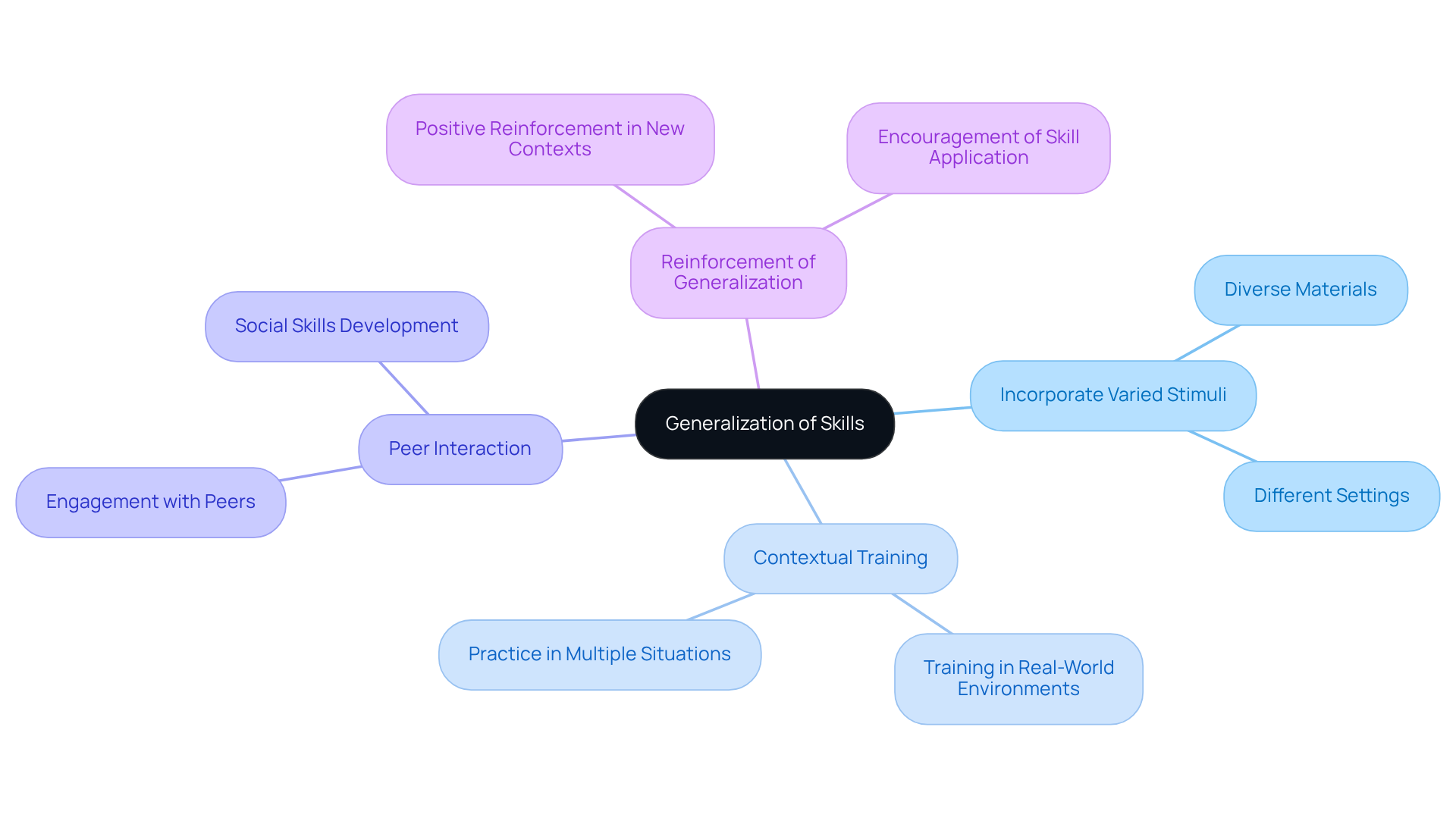
Evaluating personal requirements is essential for creating effective bias reduction programs. Board Certified Behavior Analysts (BCBAs) must conduct thorough evaluations using tools such as:
to identify each learner's unique strengths, challenges, and preferences. This comprehensive understanding allows for the personalization of development strategies, ensuring that the methods employed are both relevant and engaging for the individual. Customizing the discrimination training ABA example to specific needs not only enhances learning outcomes but also fosters greater success in skill acquisition.
Studies indicate significant advancements in cognitive abilities, language proficiency, and social competencies among youth with autism who receive personalized interventions. Recent research underscores the importance of tailored approaches, highlighting that customized development programs lead to improved engagement and motivation across diverse learners.
By prioritizing assessments, BCBAs can design targeted interventions that effectively address the varied needs of their clients, ultimately promoting better developmental outcomes. As one BCBA noted, 'Ongoing data collection is critical in individualizing and modifying each child's ABA therapy plan to help them thrive.'
To implement individualized assessments effectively, BCBAs should involve families in the assessment process, ensuring that insights from parents enhance the relevance and effectiveness of the training.
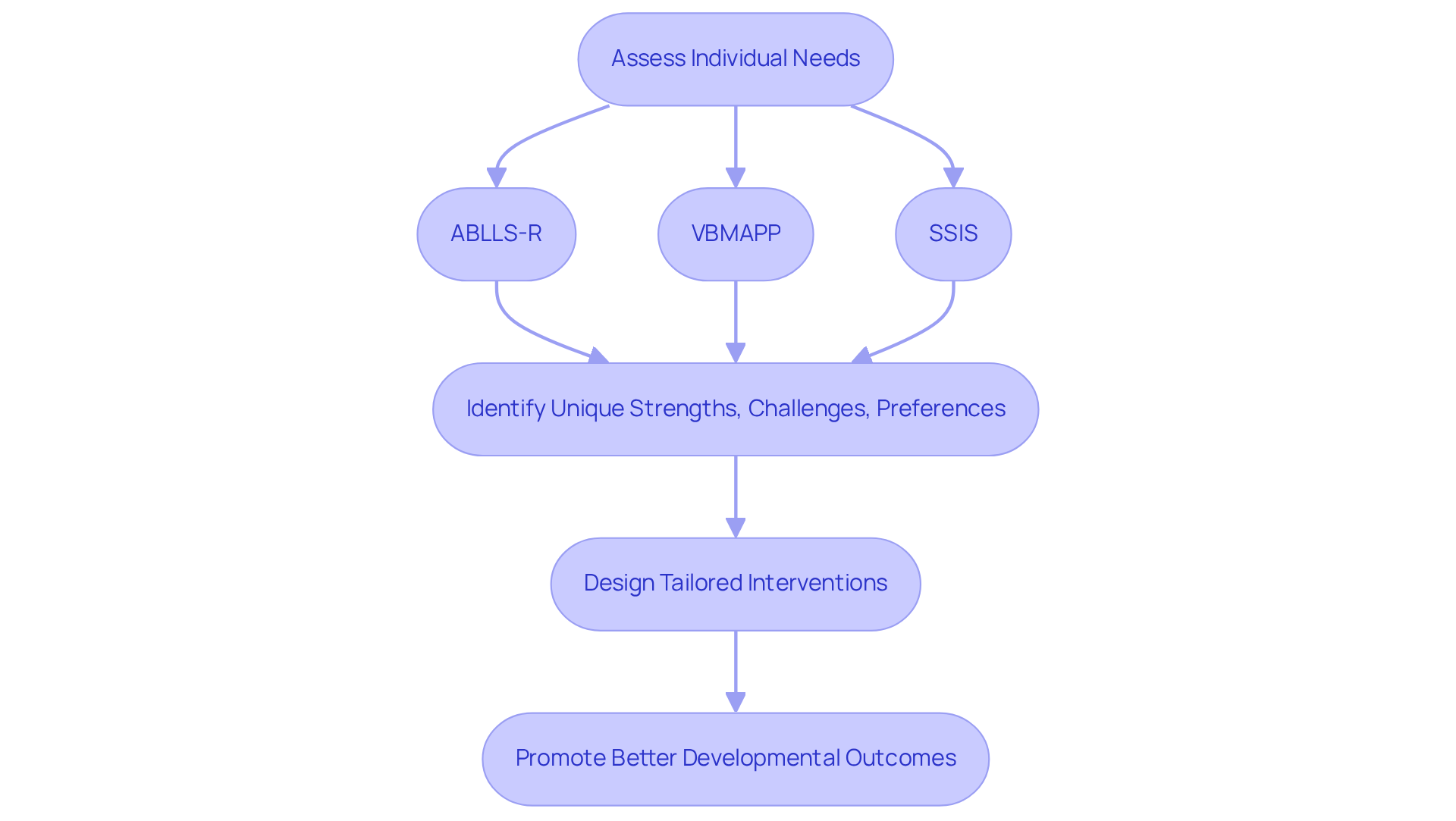
The significance of effective discrimination training in Applied Behavior Analysis (ABA) is paramount, particularly as the demand for skilled Board Certified Behavior Analysts (BCBAs) continues to rise. This article has explored various practical examples and techniques that enhance discrimination training practices, underscoring the importance of tailored approaches to address the unique needs of individuals. By integrating strategies such as reinforcement, understanding discriminative stimuli, and promoting generalization, BCBAs can significantly improve learning outcomes and empower clients to navigate their environments with confidence.
Key insights highlighted throughout the article include:
Each example serves as a reminder that successful discrimination training requires a thoughtful and structured approach, ensuring that learners are equipped with the skills needed to thrive in diverse contexts.
As the landscape of ABA therapy continues to evolve, it is essential for professionals to remain informed about effective techniques and trends in the field. Embracing innovative strategies not only enhances individual learning experiences but also contributes to the broader goal of fostering independence and confidence in those receiving support. By prioritizing customized interventions and ongoing evaluations, BCBAs can make a lasting impact on the lives of their clients, ultimately driving progress in the field of discrimination training.
What is Hire ABA and its purpose?
Hire ABA is a specialized recruitment platform dedicated to connecting Board Certified Behavior Analysts (BCBAs) with job opportunities specifically in bias reduction roles, addressing the unique needs of both job seekers and employers.
Why is there a rising demand for BCBAs?
The demand for BCBAs is projected to rise by 25% by 2026, particularly in specialized fields like bias education, due to the increasing recognition of the importance of specialized instruction in addressing behavioral challenges.
How does Hire ABA enhance the hiring process?
Hire ABA enhances the hiring process by offering personalized resume assessments and advanced job fit scoring to match qualified professionals with roles that align with their skills, career aspirations, and desired locations.
What is an example of discrimination training in ABA therapy?
An example of discrimination training in ABA therapy is teaching children to identify colors by presenting them with two colored objects, such as a red ball and a blue ball, and prompting them to point to the correct one. Positive reinforcement is provided for correct identification.
What techniques are effective for teaching colors in ABA therapy?
Effective techniques for teaching colors in ABA therapy include using visual aids, consistent repetition, and engaging activities that make learning enjoyable, along with positive reinforcement to motivate children.
What are the benefits of using positive reinforcement in ABA therapy?
Positive reinforcement motivates children and solidifies their understanding of tasks, creating a supportive environment that fosters skill acquisition and enhances developmental outcomes.
How can organizations benefit from using Hire ABA?
Organizations can benefit from using Hire ABA by streamlining their recruitment efforts and connecting with top talent in the field of Applied Behavior Analysis (ABA) therapy, enhancing overall hiring efficiency.
Our expert recruitment strategies and AI-driven sourcing ensure that you receive top-notch candidates quickly, without compromising on quality. Whether you’re looking for BCBAs, Clinical Directors, or RBTs, we’ve got you covered.